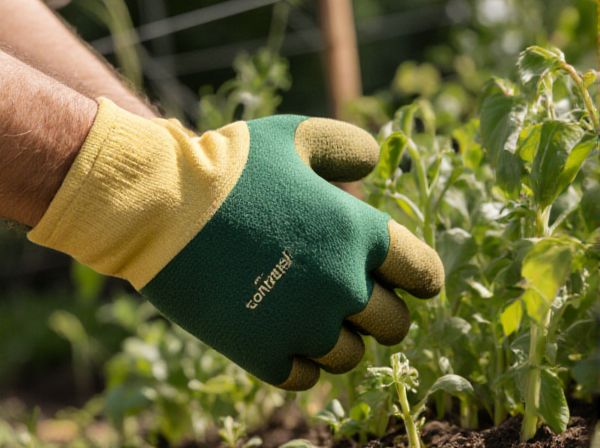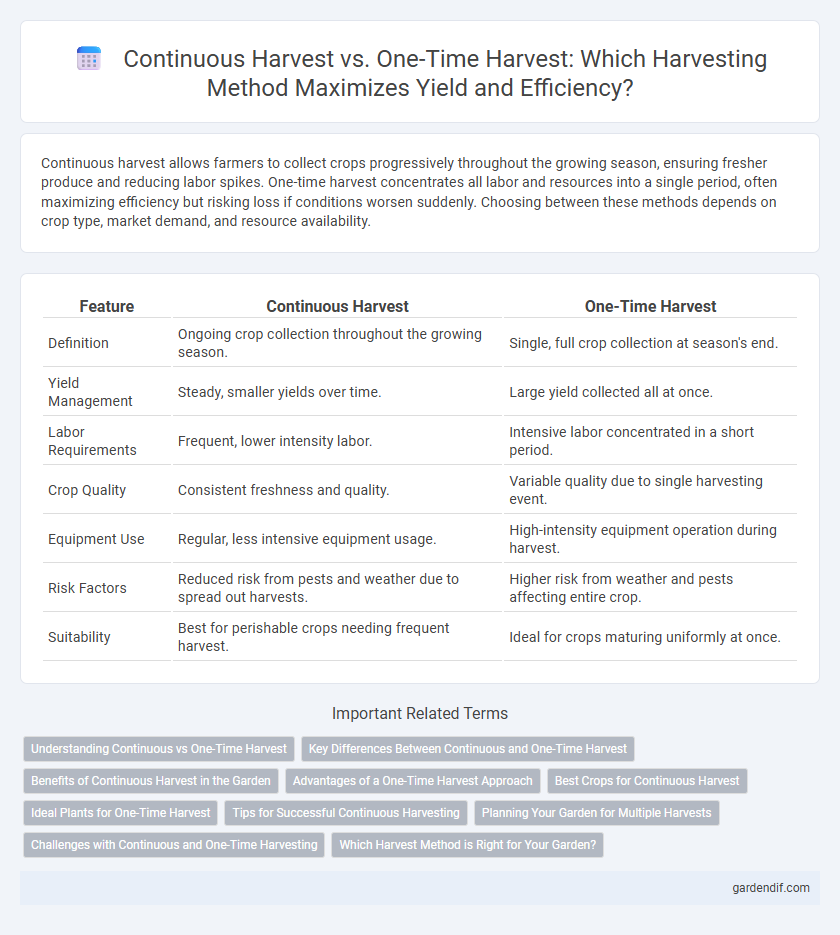
Continuous Harvest vs One-Time Harvest Illustration
Continuous harvest allows farmers to collect crops progressively throughout the growing season, ensuring fresher produce and reducing labor spikes. One-time harvest concentrates all labor and resources into a single period, often maximizing efficiency but risking loss if conditions worsen suddenly. Choosing between these methods depends on crop type, market demand, and resource availability.
Table of Comparison
| Feature | Continuous Harvest | One-Time Harvest |
|---|---|---|
| Definition | Ongoing crop collection throughout the growing season. | Single, full crop collection at season's end. |
| Yield Management | Steady, smaller yields over time. | Large yield collected all at once. |
| Labor Requirements | Frequent, lower intensity labor. | Intensive labor concentrated in a short period. |
| Crop Quality | Consistent freshness and quality. | Variable quality due to single harvesting event. |
| Equipment Use | Regular, less intensive equipment usage. | High-intensity equipment operation during harvest. |
| Risk Factors | Reduced risk from pests and weather due to spread out harvests. | Higher risk from weather and pests affecting entire crop. |
| Suitability | Best for perishable crops needing frequent harvest. | Ideal for crops maturing uniformly at once. |
Understanding Continuous vs One-Time Harvest
Continuous harvest allows for ongoing collection of crops throughout the growing season, maximizing yield and freshness by picking ripe produce as it becomes available. One-time harvest involves gathering the entire crop at once, optimizing efficiency for certain crops but risking loss of quality if some plants are not fully mature. Understanding the crop type, growth cycle, and market demand is crucial for choosing between continuous and one-time harvest methods.
Key Differences Between Continuous and One-Time Harvest
Continuous harvest involves regularly collecting crops throughout the growing season, ensuring a steady supply and reducing the risk of spoilage. One-time harvest gathers all produce simultaneously at peak maturity, optimizing bulk yield and minimizing labor frequency. The key difference lies in continuous harvest providing consistent freshness and market availability, whereas one-time harvest emphasizes efficiency and large-scale processing.
Benefits of Continuous Harvest in the Garden
Continuous harvest in the garden maximizes yield by allowing plants to produce fresh fruits and vegetables over an extended period rather than all at once. This method promotes healthier plants through regular pruning and reduces waste by harvesting only mature produce. Continuous harvesting also supports sustainable gardening practices by maintaining soil fertility and encouraging consistent plant growth cycles.
Advantages of a One-Time Harvest Approach
A one-time harvest approach offers advantages such as reduced labor costs and simplified logistics compared to continuous harvesting. It allows for maximum crop yield at peak ripeness, ensuring uniform quality and optimal market timing. This method also minimizes equipment wear and facilitates efficient post-harvest processing and storage management.
Best Crops for Continuous Harvest
Leafy greens such as lettuce, spinach, and kale are ideal for continuous harvest due to their rapid growth and ability to regenerate after cutting. Herbs like basil, mint, and chives also thrive with regular picking, providing fresh yields throughout the growing season. These crops maximize productivity and ensure a steady supply of fresh produce compared to a one-time harvest approach.
Ideal Plants for One-Time Harvest
Ideal plants for one-time harvest include root vegetables like carrots, beets, and potatoes, as well as grains such as wheat and corn, which reach peak maturity simultaneously. These crops are typically planted and grown to full maturity before harvesting all at once, maximizing yield efficiency. One-time harvest plants benefit from minimal ongoing maintenance and are well-suited for large-scale farming operations seeking bulk production.
Tips for Successful Continuous Harvesting
Continuous harvesting requires selecting fast-growing, high-yield crops like lettuce or spinach to maintain a steady supply. Implement succession planting at regular intervals and ensure consistent watering and nutrient management to promote healthy growth. Utilize proper pruning techniques and monitor pest control to maximize yield throughout the harvesting period.
Planning Your Garden for Multiple Harvests
Planning your garden for multiple harvests involves selecting crops with staggered maturity rates and implementing a planting schedule to optimize space and yield. Continuous harvest techniques, such as succession planting and intercropping, ensure fresh produce over an extended period compared to a one-time harvest that yields all at once. Utilizing these strategies maximizes garden productivity and provides a steady supply of fruits and vegetables throughout the growing season.
Challenges with Continuous and One-Time Harvesting
Continuous harvest demands efficient resource management and constant monitoring to maintain crop quality, often increasing labor costs and operational complexity. One-time harvest can lead to significant crop loss due to timing challenges and is more susceptible to adverse weather impacts, limiting overall yield potential. Both methods require tailored strategies to address pest control and soil health, with continuous harvest presenting higher risks of soil depletion and disease spread.
Which Harvest Method is Right for Your Garden?
Continuous harvest promotes steady yields by picking ripe fruits or vegetables regularly, ideal for gardeners seeking fresh produce throughout the growing season. One-time harvest suits crops that mature simultaneously, allowing efficient collection but requiring ample storage or immediate processing. Choosing the best method depends on your garden size, crop type, and consumption habits to maximize freshness and reduce waste.
Continuous Harvest vs One-Time Harvest Infographic

 gardendif.com
gardendif.com